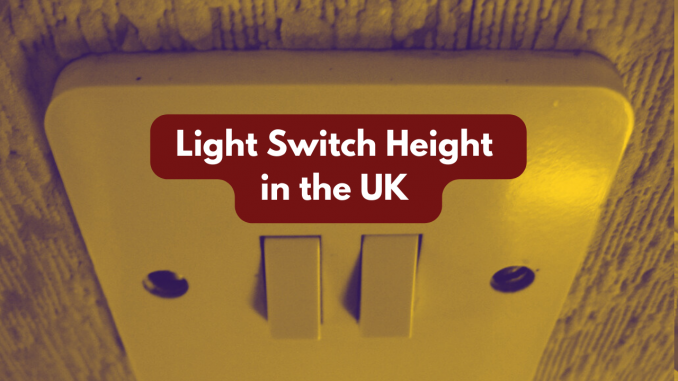
The average height for mounting a light switch in the UK is about 1.2 meters (approximately 4 feet) above the finished floor level. This height is a common standard used for installing light switches in residential buildings. However, it’s important to note that there can be some variation based on personal preference, ceiling heights, bedroom sizes, accessibility needs, and specific building codes or regulations in certain situations.
The recommended height of 1.2 meters is a comfortable height for most people to reach and operate a light switch without much effort. It is a standard practice, but it’s not an absolute requirement, and there may be exceptions or adjustments made in certain cases to accommodate individuals with disabilities or specific building design considerations. Always consult with local building codes and regulations or consider the needs of the users when determining the exact placement of light switches in a particular space.
Regulations for Installing a Light Switch
The installation of light switches in the UK is subject to various regulations and safety standards. These regulations are designed to ensure electrical safety and compliance with building codes. If you are looking to renovate a budget, DIY electrical work is generally discouraged, except for minor tasks like changing a light bulb or a plug.
Firstly, it must be installed by a qualified electrician. Electrical work in the UK should be carried out by a qualified and registered electrician. This is a legal requirement to ensure that the work is done safely and complies with all relevant regulations.
BS 7671 Wiring Regulations: The installation and light switch wiring of electrical systems, including light switches, must adhere to the British Standard BS 7671:2018, also known as the IET Wiring Regulations. These regulations set the standards for electrical installations and cover various aspects, including circuit protection, earthing, and equipment selection. There are also additional regulations that need to be considered, such as Part P Building Regulations: In England and Wales, Part P of the Building Regulations applies to electrical installations. It requires that certain electrical work, including the installation of new circuits and light switches, must be notified to the local building control authority or completed by a registered electrician. Different regulations may apply in Scotland and Northern Ireland.
Light Switch Location and Accessibility
Light switches should be installed in accessible and convenient locations. There are no specific height requirements, but a typical height for light switches is around 1.2 meters (approximately 4 feet) from the finished floor level. However, the exact placement may vary depending on specific needs, such as accommodating individuals with disabilities.
The type of switch used should be appropriate for its intended purpose. Common types include single-pole, two-way, and intermediate switches. Different situations may require different switch types to control lighting circuits effectively.
It’s essential to consult with a qualified electrician and, if necessary, your local building control authority to ensure that your light switch installations comply with all relevant regulations and safety standards. Failure to follow these regulations can result in unsafe electrical installations and legal consequences.
UK Light Switch Dimensions
In the UK, the normal size of a light switch is typically a standard rectangular switch plate that measures about 86 millimeters (mm) in height and 86 mm in width (approximately 3.4 inches by 3.4 inches). This size is commonly referred to as a “single-gang” switch plate.
However, there are also larger switch plates available, known as “double-gang” and “triple-gang” switch plates, which are used when you have multiple switches in one location, such as a double switch controlling two different lights. Double-gang switch plates are typically about 146 mm (5.75 inches) wide, and triple-gang switch plates are wider still.
It’s important to note that switch plate sizes can vary slightly depending on the manufacturer and style, but the dimensions mentioned above are the most common standard sizes for light switches in the UK.

Leave a Reply